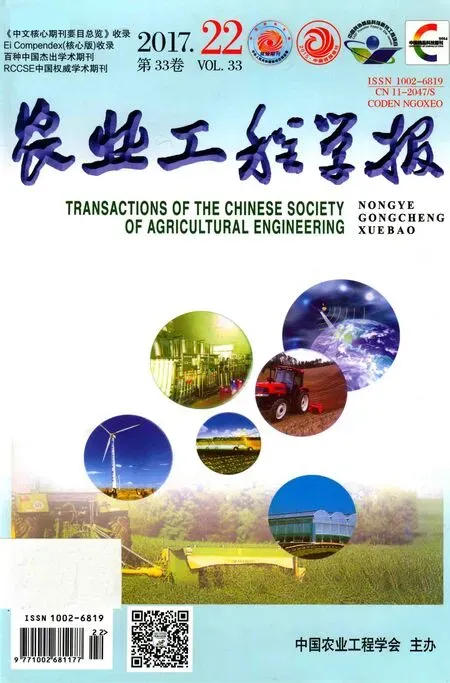基于分析法的粮食逆流干燥系统能效评价与试验
马兴灶,方壮东,李长友
马兴灶1,2,方壮东2,李长友2※
(1. 岭南师范学院机电工程学院,湛江 524048;2. 华南农业大学工程学院,广州 510642)
为客观、合理地评价粮食逆流干燥系统的能效,实现粮食高效节能干燥,该文基于㶲分析法,从气流状态变化考察逆流连续式干燥工艺系统的能量利用程度。结果表明:在试验条件下,干燥机内各干燥段能量利用效果较好。在高温和低温干燥段,排气和干燥室热损失率最高分别不超过6.68%、11.09%和21.26%、9.37%,热效率和㶲效率不低于83.02%、68.1%和69.37%、56.22%;在冷却段,由于粮温比风温高,风对稻谷有明显的降温去水作用。而系统的平均热效率和㶲效率为80.24%和64.52%,表明系统能量匹配效果较好,稻谷的平均单位热耗量为2 944.6 kJ/kg,与国标≤7 400 kJ/kg相比,节能达到60.2%,节能效果明显。研究结果为干燥工艺设计、探索节能的途径和制定粮食干燥系统能效评价标准提供参考。

0 引 言
中国是世界上最大的粮食生产及消费国,2015年粮食总产量高达6.2亿t,粮食干燥机械化需求迫切。然而截止2014年底,全国拥有的粮食干燥机达5.44万台,机械干燥粮食数量8 935.72万t[1],据此计算中国的粮食干燥机械化程度还不足15%,与美、日等发达国家20世纪80年代已达95%的水平相差甚远,与目前全国农作物耕种收综合机械化率已达63.8%的水平相比,发展很不平衡[2]。近年,在国家良好的政策导向下,烘干机市场持续走热,设备数量增长很快,但整体市场比较混乱,新技术应用不足,设备制造质量不高、适应性、通用性、可靠性、安全性差,能耗高、效率低、品质不能保障。导致问题的原因有多方面,其中设备能效评价标准不科学是问题的根源之一。
近年来,国内外学者基于特定干燥试验,探讨干燥工艺参数[3-8],分析了干燥系统能耗[9-13],提出了一些节能措施[14-18]。但迄今,研究人员设计、评价干燥系统的误区之一是把注意力放在了提高人为提供的热能消耗和干燥动力上,忽视了客观㶲的作用,评价标准不够科学。充分利用客观㶲,增大动力系数是实现绿色、高效节能的关键。同一物料在同样的干燥动力条件下,采用不同的干燥工艺和处理方式,其能量的利用效果有很大差别[19-20]。㶲概念的引入,解决了利用一个单独的物理量来揭示系统能量价值问题,改变了人们对能的性质、损失、转换效率等传统的看法,提供了用能分析的科学基础,能够全面深刻地揭示系统内部损失、能量的价值以及在各环节上损耗的特征。基于干燥㶲分析法[21-24],揭示粮食逆流干燥工艺系统的热能结构,对评价干燥系统有效能利用效率具有较高的理论价值和重要的现实意义。
因此,为客观、合理地评价干燥系统的能效,实现粮食高效节能干燥,本文基于干燥系统热质衡算和热效率与㶲效率分析方法,从逆流干燥系有效能动态变化过程,考察逆流连续式干燥工艺系统的能量利用程度,利用5HNH-15型干燥机考证评价结果的可靠性,为提高粮食干燥效率和探索节能的途径提供分析方法,为干燥工艺系统设计和制定粮食干燥能效评价标准提供一些参考。
1 干燥系统热质衡算
粮食干燥是一个输入能量、介质和湿粮,排出废气、得到干粮的开口系统,干燥过程必然要进行物质和热量的交换,为准确把握系统内部能量消耗的本质,必须基于物质守恒和能量守恒原则,对系统进行计算。系统干燥过程的计算包括物料衡算和热量衡算两部分,图1所示即为整个干燥过程的物料衡算和热量衡算过程参数。粮食逆流干燥系统热质衡算示意图如图1所示。
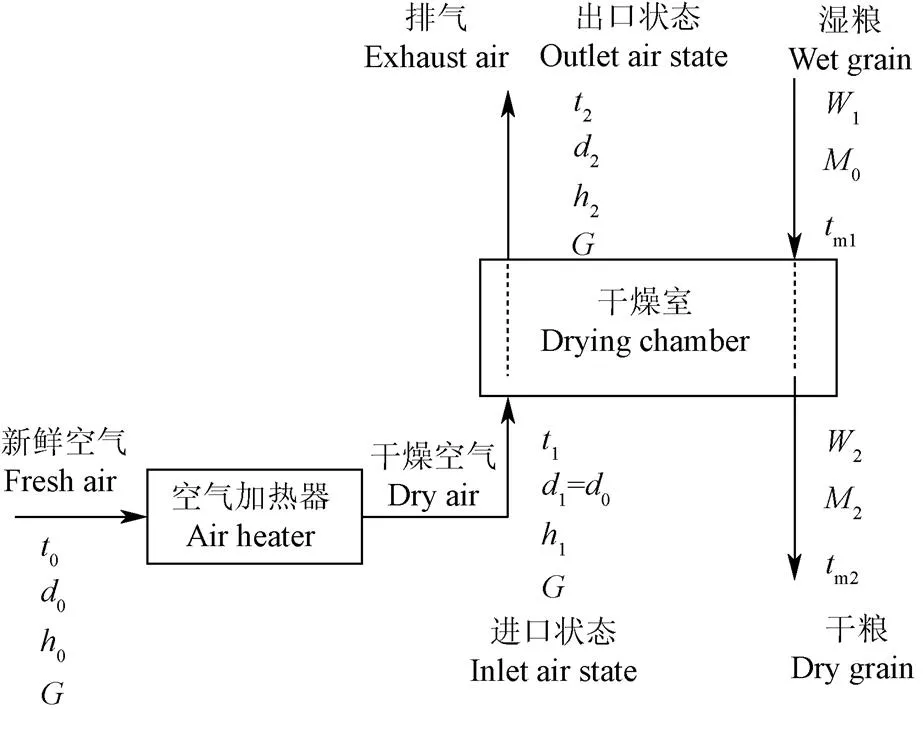
注:t0为空气初始温度,℃;d0为空气初始含湿量,kg·kg-1;h0为空气初始热焓,kJ·kg-1;G为绝干空气的质量流量,kg·h-1;t1为加热后空气温度,℃;d1为加热后空气含湿量,kg·kg-1;h1为加热后空气热焓,kJ·kg-1;t2为排气温度,℃;d2为排气湿含量,kg·kg-1;h2为排气热焓,kJ·kg-1;W1、W2分别为干燥前后粮食的质量流量,kg·h-1;M0、M2分别为粮食初始和终了含水率,%;tm1、tm2分别为粮食干燥前后的温度,℃。
1.1 干燥过程的物料衡算
1.1.1 粮食的去水量
在粮食干燥过程中,粮食与干燥介质进行物质与能量交换,在这个干燥过程中一直保持恒定不变的量为介质中的绝干空气量和进入、输出干燥室的绝干粮食量,以1,2表示干燥前后粮食的质量流量,kg/h;以W表示干燥过程中绝干粮食的质量流量,kg/h;以表示干燥过程中蒸发的水分的质量流量,kg/h;则有:


化简得:

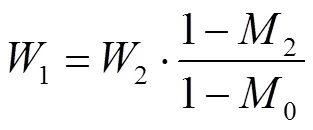
式中0,2为干燥前后粮食的湿基含水率,%。
1.1.2 气耗量
环境空气先经过加热器加热后变为干燥空气,送入干燥室,与粮食接触进行热质交换后,排出干燥室;粮食经输送装置进入干燥室,与干燥空气进行热质交换后,排出干燥室。在这个过程中,对进出干燥室的干燥空气的水分进行衡算,则有:

式中为干燥过程中绝干空气的质量流量,kg/h;1,2为空气进入和排出干燥室时的含湿量,kg/kg。
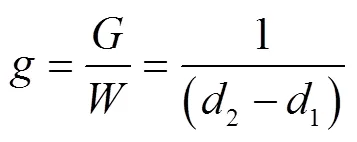
式中称为比空气用量或单位空气消耗量,简称气耗量,即从湿物料中蒸发1 kg水分所需的干空气量,kg/kg。由式(6)可见,比空气用量只与空气的最初和最终湿度有关,而与干燥过程所经历的途径无关。
1.2 干燥过程的热量衡算
粮食干燥过程的热量衡算包括介质的降温增湿过程的热量、粮食升温去湿过程的热量和系统损耗,其整个干燥过程中介质和粮食组成的干燥系统的热量衡算,如式(7)所示:


环境空气进入空气加热器(换热器)升温过程,可用式(8)表示:

式中1为加热后干燥空气的热焓,kJ/kg。
仅考察干燥室的热量衡算表达式,根据能量守恒定律,则有:

2 干燥系统能量结构分析
2.1 湿空气状态参数
湿空气中包含的水蒸气质量与其中的干空气质量之比为空气的湿含量,在一定的大气压力下,湿空气的含湿量可由式(10)计算[25]:

其中

式中为湿空气含湿量,kg/kg;为空气的相对湿度,%;P为环境温度t下的湿空气饱和蒸汽压力,Pa;P为环境温度t下的环境大气压力,Pa;t为湿空气的温度,℃。
湿空气的热焓是指包含1 kg干空气的湿空气具有的热焓量,即1 kg干空气及与其混合的水蒸气的焓之和,在湿空气温度t下,湿空气的热焓可由式(12)计算:
=1.005t+(2 501+1.86t) (12)
式中为湿空气的热焓,kJ/kg。
2.2 干燥系统能效分析
干燥系统的状态变化和能量结构如图2所示。在干燥系统内部,粮食的去水量等于介质的增湿量,当粮食水分蒸发消耗的汽化潜热和谷物升温、蒸发出的水分升温、介质流动功损以及干燥室散热热损失完全来自进入系统中介质的显热时,那么,在定压状态下,干燥介质从加热器中获取的热量则全部体现在自身焓的变化上。由图2可以看出,介质初始状态为状态点0,从状态点0经过人为供给热量等湿加热到状态点1;假设介质在干燥室内与粮食自发地进行热质交换后,从状态点2排出干燥室,在此过程中,干燥介质经历的是一个增湿降温的过程,粮食经历的是一个去湿的过程,粮食本身温度变化可以是升温、等温或者降温,干燥过程中,粮食从初始状态点4到达了状态点3。

注:0为初始状态和环境态,1和2为干燥室进气和排气状态点,2′为介质升温热损失状态点,3为干粮状态,4为湿粮状态;h0为空气初始热焓,kJ·kg-1;h1为加热后空气热焓,kJ·kg-1;h2为实际进气热焓,kJ·kg-1;h′2为排气热焓,kJ·kg-1;he0为零㶲点热焓,kJ·kg-1;t0为空气初始温度,℃;t1为加热后空气温度,℃;tg0、tg2分别为粮食初始温度和终了温度,℃;t2为排气温度,℃;t′为零㶲点温度,℃;φ1、φ2分别是进气和排气相对湿度,%;M0、M2分别为粮食初始和终了含水率,%;d0、d2分别为进气和排气含湿量,kg·kg-1;t12表示介质进入干燥室实际温度,℃。
2.2.1 干燥室的热效率

如果粮食水分蒸发完全看作是换热器提供给介质的热能产生的结果,则干燥室的热效率可被表示为式(13)
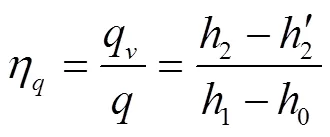
2.2.2 干燥室的㶲效率


3 干燥效能的试验考证
3.1 试验内容与方法
试验样机为5HNH-15型多段逆流干燥缓苏连续式干燥机,机内静容积169 m3,标准机内容量93 t稻谷,其结构图如图3所示,各干燥段参数见文献[29];粮食为湘早籼45号,进入干燥机前的平均湿基含水率为24.06%,试验地点为湖南省宁乡县卫红米业有限公司,试验时间为2015年7月25日,试验当天天气晴朗,试验时平均温度为32.4 ℃,相对湿度平均值为55.74%,高温风机、低温风机和冷风机的风量分别为56 800、37 864和11 000 m³/h;干燥机平均排粮量约为12.5 t/h。试验主要测试仪器如表1所示。
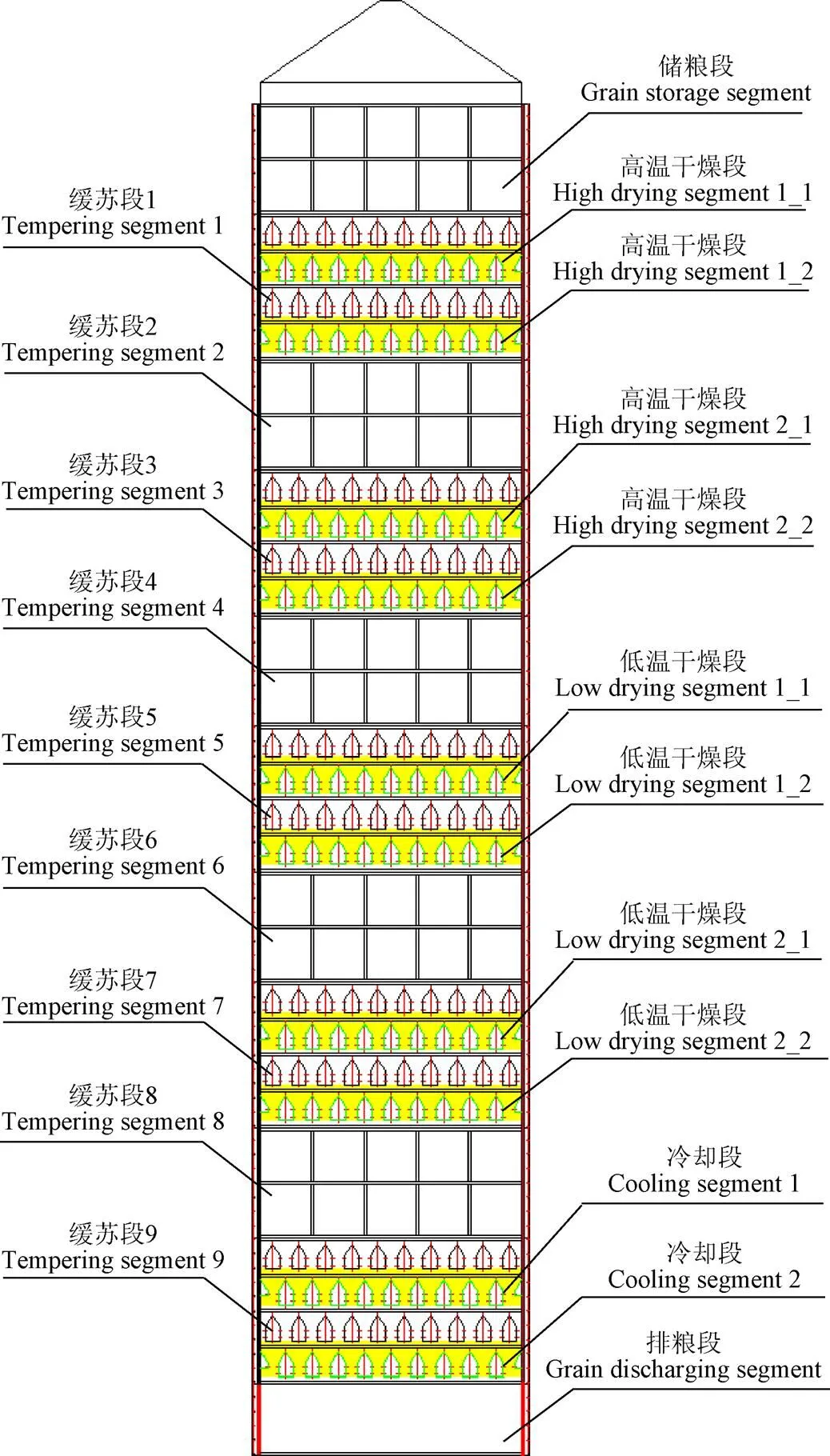
图3 干燥机结构图
试验过程中,自主开发了实时跟踪记录从换热器进入风道的高温干燥段(HDS,High drying segment)、低温干燥段(LDS,Low drying segment)与冷却段(CS,Cooling segment)的进风温度、各干燥段排气温湿度和环境温湿度的数据采集系统,系统界面如图4所示,系统每隔5 min保存数据一次。待工作稳定后,连续采集干燥机的气流状态变化数据,同时分时段对各干燥段和排粮口的粮食采样进行含水率和粮温测定,采样点位置如图4所示。
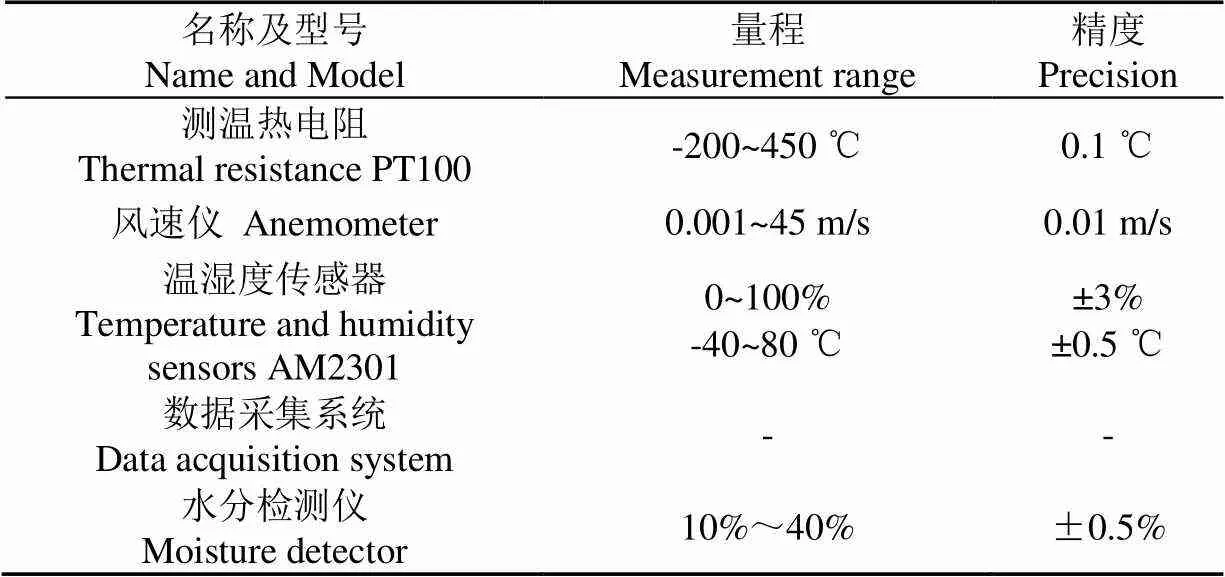
表1 试验测试仪器
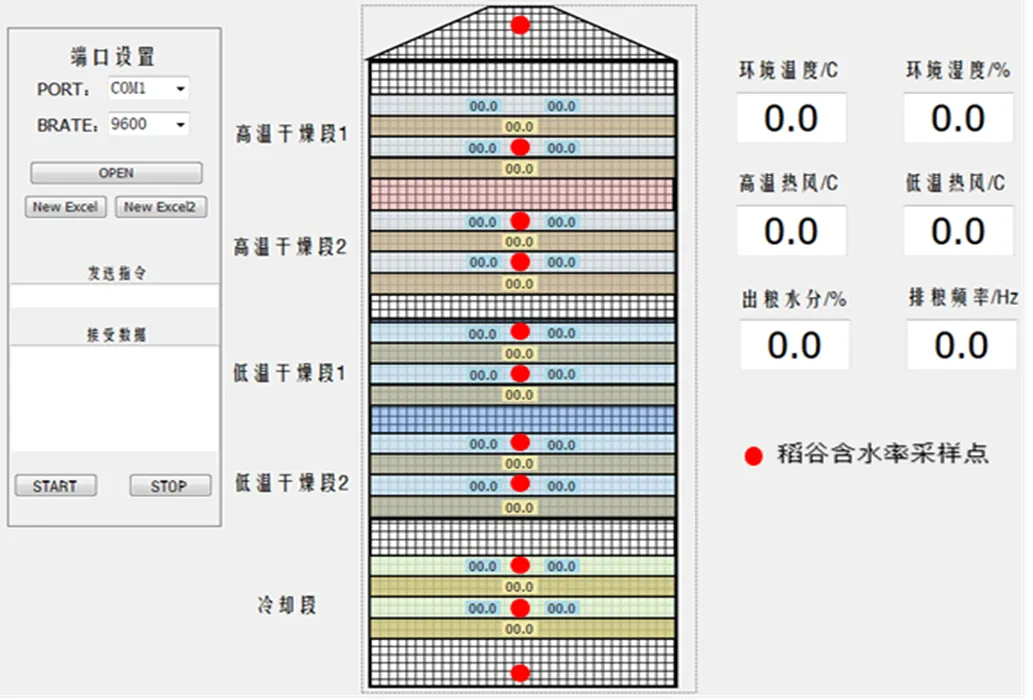
图4 数据采集系统界面
3.2 试验结果及分析
由于连续式干燥机内粮食经历所有干燥过程的时长约为5~10 h,为准确、客观地分析干燥系统能效,需连续记录足够的过程参数求平均。因此,待干燥机达到稳定工作状态后,连续3 d跟踪记录干燥现场数据,记录数据按每小时求平均,随机选取2015年7月25日10:00-20:00连续10 h干燥现场数据进行分析,试验结果如表2和表3所示。
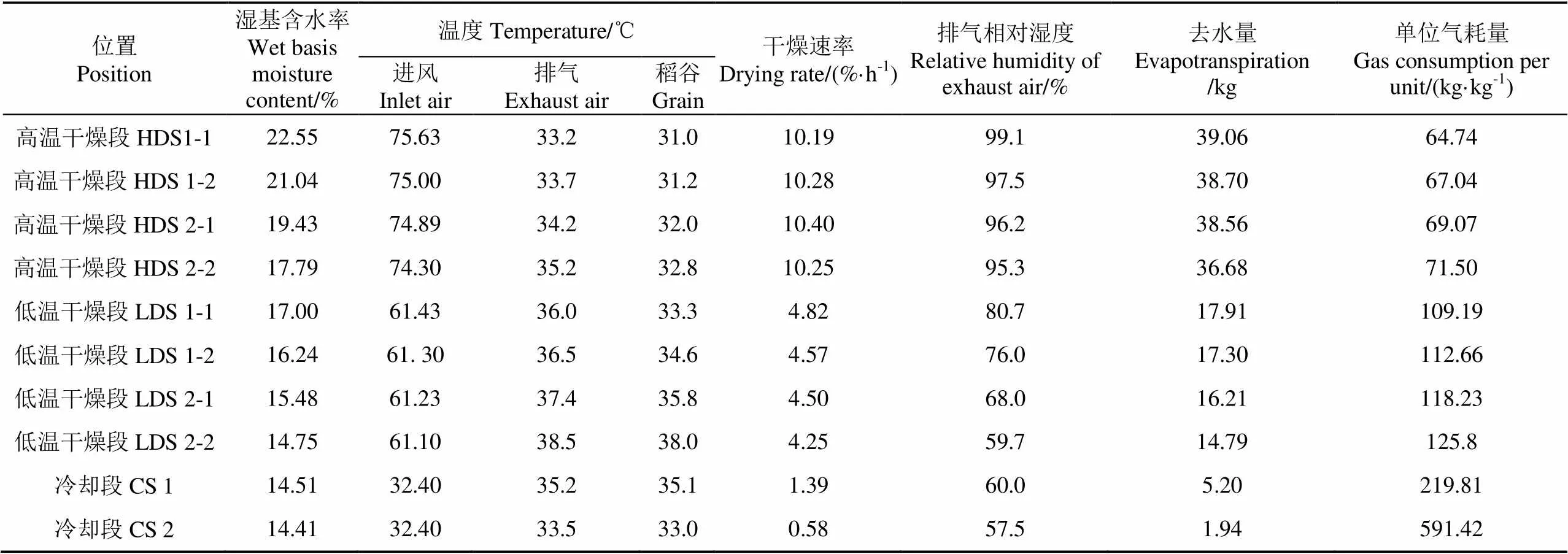
表2 5HNH-15型连续式干燥机热风干燥试验测试数据
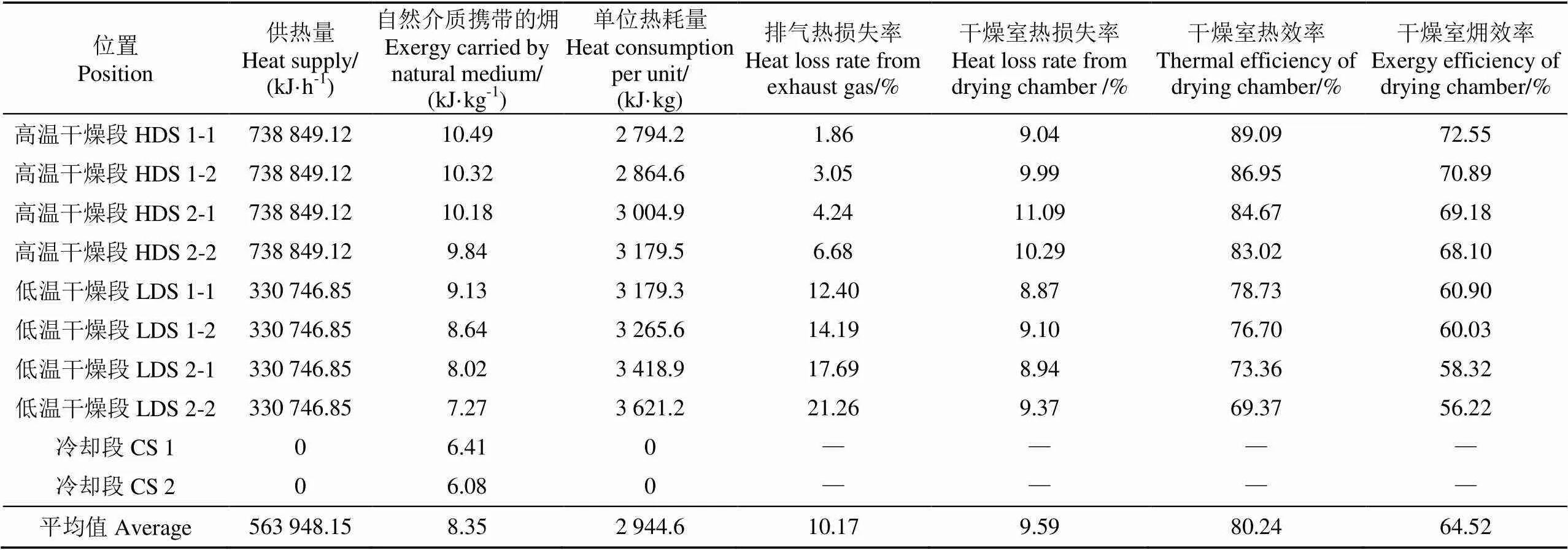
表3 5HNH-15型连续式干燥机能效评价
由表2和表3可以看出:
1)在试验条件下,干燥机内各干燥段能量利用效果较好。在高温干燥段,排气热损失率和干燥室热损失率最高不超过6.68%和11.09%,干燥室热效率和㶲效率不低于83.02%和68.10%;在低温干燥段,排气热损失率和干燥室热损失率最高不超过21.26%和9.37%,干燥室热效率和㶲效率不低于69.37%和56.22%;而在冷却段,由于粮温比风温高,风对稻谷有明显的降温去水作用。从表2和表3可以看出,干燥室的平均热效率和㶲效率分别为80.24%和64.52%,说明干燥过程的能量匹配比较理想,但仍有一定的提升空间。
2)从最初干燥室的热损失率为1.86%,而在干燥后期为21.26%,对应的干燥室的热效率由最初的89.09%降低到了69.37%,干燥室的㶲效率由最初的72.55%降低到56.22%,证实了粮食热风干燥消耗的能量中不仅有主观㶲,也包含有客观㶲,评价干燥能效不能忽视客观干燥㶲的作用。
3)整个干燥过程,稻谷的平均单位热耗量为 2 944.6 kJ/kg,与国标≤7 400 kJ/kg相比,节能达到60.2%,系统节能效果明显。
4)稻谷在干燥机内经历的是先升温再降温的过程,在冷却段,经过常温空气的冷却,稻谷得到了很好降温。在整个干燥过程中,粮温随含水率的降低而缓慢升高,最高不超过38.0 ℃,温度基本接近或者低于稻谷玻璃态转化温度[30],较好的保证了稻谷干燥品质。
4 结 论
1)在试验条件下,干燥机内各干燥段能量利用效果较好。在高温和低温干燥段,排气和干燥室热损失率最高分别不超过6.68%、11.09%和21.26%、9.37%,热效率和㶲效率不低于83.02%、68.1%和69.37%、56.22%;在冷却段,由于粮温比风温高,风对稻谷有明显的降温去水作用。
2)稻谷的平均单位热耗量为2 944.6 kJ/kg,与国标≤7 400 kJ/kg相比,节能达到60.2%,系统节能效果明显。
3)合理设计稻谷干燥工艺过程,可使稻谷温度基本接近或者低于稻谷玻璃态转化温度,较好的保证了稻谷干燥品质。
[1] 孙超,耿楷敏. 粮食干燥技术装备发展现状及建议[J]. 农机质量与监督,2015(12):18-19.
[2] 李长友. 广东省粮食干燥机械化装备技术发展研讨[J]. 现代农业装备,2014(1):41-48.
[3] 陈坤杰,李娟玲,杨明毅,等. 稻谷固定床式深层干燥试验研究[J]. 农业机械学报,2001,32(2):58-61.
Chen Kunjie, Li Juanling, Yang Mingyi, et al. Drying experiments of paddy in a deep fixed-bed[J]. Transactions of the Chinese Society for Agricultural Machinery, 2001, 32(2): 58-61. (in Chinese with English abstract)
[4] 胡万里,李长友,徐凤英. 稻谷薄层快速干燥工艺的试验[J]. 农业机械学报,2007,38(4):103-106.
Hu Wanli, Li Changyou, Xu Fengying. Experimental study on fast dry craft of rough rice thin layer[J]. Transactions of the Chinese Society for Agricultural Machinery, 2007, 38(4): 103-106. (in Chinese with English abstract)
[5] 殷丽春,毛志怀. 玉米薄层干燥的试验研究[J]. 农机化研究,2005(1):197-198.
Yin Lichun, Mao Zhihuai. Research on thin-layer maize drying[J]. Journal of Agricultural Mechanization Research, 2005(1): 197-198.(in Chinese with English abstract)
[6] 马兴灶,李长友,张晓立,等. 温度势差驱动玉米去水试验研究[J]. 农产品加工:学刊,2010(10):8-10.
Ma Xingzao, Li Changyou, Zhang Xiaoli, et al. Dehydration of maize by temperature difference [J]. Academic Periodical of Farm Products Processing, 2010(10): 8-10. (in Chinese with English abstract)
[7] 刘启觉. 高水分稻谷干燥工艺试验研究[J]. 农业工程学报,2005,21(2):135-139.
Liu Qijue. Experimental research on drying technology for high moisture content paddy[J]. Transactions of the Chinese Society of Agricultural Engineering (Transactions of the CSAE), 2005, 21(2): 135-139. (in Chinese with English abstract)
[8] 郑先哲,夏吉庆,杨悦乾. 增湿加热稻谷干燥工艺的试验研究[J]. 农业工程学报,2000,16(3):81-83.
Zheng Xianzhe, Xia Jiqing, Yang Yueqian. Experimental study on paddy drying technology by using humidified and heated air[J]. Transactions of the Chinese Society of Agricultural Engineering (Transactions of the CSAE), 2000, 16(3): 81-83. (in Chinese with English abstract)
[9] 王润发,方壮东,王鹏程,等. 稻谷多场协同干燥系统设计与试验[J]. 农机化研究,2017,39(6):96-100.
Wang Runfa, Fang Zhuangdong, Wang Pengcheng, et al. Design and experiment of multi-field synergy drying system for paddy[J]. Journal of Agricultural Mechanization Research, 2017, 39(6): 96-100. (in Chinese with English abstract)
[10] 王丹阳,李成华,佟玲,等. 深床干燥工艺参数对稻谷干燥比能耗的影响[J]. 沈阳农业大学学报,2008,39(5):593-597.
Wang Danyang, Li Chenghua, Tong Ling, et al. Influence of drying parameters on efficiency rate of rice in a deep fixed-bed [J]. Journal of Shenyang Agricultural University, 2008, 39(5): 593-597. (in Chinese with English abstract)
[11] Motevali Ali, Minaei Saeid, Khoshtagaza Mohammad Hadi. Evaluation of energy consumption in different drying methods [J]. Energy Conversion & Management, 2011, 52(2): 1192-1199.
[12] Syahrul S, Hamdullahpur F, Dincer I. Exergy analysis of fluidized bed drying of moist particles[J]. Exergy An International Journal, 2002, 2(2): 87-98.
[13] Sarker Md Sazzat Hossain, Ibrahim Mohd Nordin, Aziz Norashikin Abdul, et al. Energy and exergy analysis of industrial fluidized bed drying of paddy[J]. Energy, 2015, 84: 131-138.
[14] 李长友,麦智炜,方壮东,等. 种子循环干燥系统设计与试验[J]. 农业机械学报,2014,45(6):242-248.
Li Changyou, Mai Zhiwei, Fang Zhuangdong, et al. Development of seed circulation drying system[J]. Transactions of the Chinese Society for Agricultural Machinery, 2014, 45(6): 242-248. (in Chinese with English abstract)
[15] 邸坤,李杰,马云霞,等. 我国粮食干燥节能途径[J]. 干燥技术与设备,2005,3(4):207-210.
Di Kun, Li Jie, Ma Yunxia, et al. Approaches to energy saving in grain drying process[J]. Drying Technology & Equipment,2005, 3(4): 207-210. (in Chinese with English abstract)
[16] 王德华,董殿文,汪喜波,等. 干燥系统节能减排技术研究与实施[J]. 粮食加工,2009,34(3):63-77.
[17] 尹晓慧,尹思万. 顺流连续式粮食干燥机节能工艺探讨[J]. 现代化农业,2009(4):42.
[18] 李长友,张烨,麦智炜. 高湿粮食贮藏干燥机设计与试验[J]. 农业机械学报,2014,45(4):231-235.
Li Changyou, Zhang Ye, Mai Zhiwei. Design and experiment of dryer for high moisture grain storage[J]. Transactions of the Chinese Society for Agricultural Machinery, 2014, 45(4): 231-235. (in Chinese with English abstract)
[19] 李长友,马兴灶,麦智炜. 粮食热风干燥含水率在线模型解析[J]. 农业工程学报,2014,30(11):10-20.
Li Changyou, Ma Xingzao, Mai Zhiwei. Analytical study on on-line model of moisture in hot air drying process of grain[J]. Transactions of the Chinese Society of Agricultural Engineering (Transactions of the CSAE), 2014, 30(11): 10-20. (in Chinese with English abstract)
[20] 李长友,方壮东. 高湿稻谷多段逆流干燥缓苏解析模型研究[J]. 农业机械学报,2014,45(5):179-184.
Li Changyou, Fang Zhuangdong. Analytical models of multistage counter flow drying and tempering process of grain[J]. Transactions of the Chinese Society for Agricultural Machinery, 2014, 45(5): 179-184. (in Chinese with English abstract)
[21] 李长友,麦智炜,方壮东. 粮食水分结合能与热风干燥动力解析法[J]. 农业工程学报,2014,30(7):236-242.
Li Changyou, Mai Zhiwei, Fang Zhuangdong. Analytical study of grain moisture binding energy and hot air drying dynamics[J]. Transactions of the Chinese Society of Agricultural Engineering (Transactions of the CSAE), 2014, 30(7): 236-242. (in Chinese with English abstract)
[22] 李长友,马兴灶,方壮东,等. 粮食热风干燥热能结构与解析法[J]. 农业工程学报,2014,30(9):220-228.
Li Changyou, Ma Xingzao, Fang Zhuangdong, et al. Thermal energy structure of grain hot air drying and analytical method[J]. Transactions of the Chinese Society of Agricultural Engineering (Transactions of the CSAE), 2014, 30(9): 220-228. (in Chinese with English abstract)
[23] 李长友. 粮食热风干燥系统㶲评价理论研究[J]. 农业工程学报,2012,28(12):1-6.
Li Changyou. Exergy evaluation theory of hot air drying system for grains[J]. Transactions of the Chinese Society of Agricultural Engineering (Transactions of the CSAE), 2012, 28(12): 1-6. (in Chinese with English abstract)
[24] 马兴灶. 粮食干燥水分在线解析与能效评价研究[D]. 广州:华南农业大学,2016.
Ma Xingzao. Moisture Online Analysis and Energy Efficiency Evaluation of Grain Drying[D]. Guangzhou: South China Agricultural University, 2016. (in Chinese with English abstract)
[25] 李长友. 热工基础[M]. 北京:中国农业大学出版社,2011.
[26] Midilli A, Kucuk H. Energy and exergy analyses of solar drying process of pistachio[J]. Energy, 2003(28): 539-556.
[27] Syahrul S, Hamdullahpur F, Dincer I. Exergy analysis of fluidized bed drying of moist particles[J]. Exergy 2002(2): 87-98.
[28] 张烨. 高湿粮食集中干燥装备工艺系统设计与试验[D]. 广州:华南农业大学, 2015.
Zhang Ye. Designing and Testing on Concentrated Drying Equipment Process System of High Moisture Grain[D]. Guangzhou: South China Agricultural University, 2015. (in Chinese with English abstract)
[29] 李长友,麦智炜,方壮东,等. 高湿稻谷节能干燥工艺系统设计与试验[J]. 农业工程学报,2014,30(10):1-9.
Li Changyou, Mai Zhiwei, Fang Zhuangdong, et al. Design and test on energy-saving drying system for paddy with high moisture content[J]. Transactions of the Chinese Society of Agricultural Engineering (Transactions of the CSAE), 2014, 30(10): 1-9. (in Chinese with English abstract)
[30] 刘木华. 水稻干燥品质的模拟和控制机理研究[D]. 北京:中国农业大学,2000.
Liu Muhua. Study on Simulation and Control Mechanism of Rice Drying Quality[D]. Beijing: China Agricultural University, 2000. (in Chinese with English abstract)
Ma Xingzao, Fang Zhuangdong, Li Changyou. Energy efficiency evaluation and experiment on grain counter-flow drying system based on exergy analysis[J]. Transactions of the Chinese Society of Agricultural Engineering (Transactions of the CSAE), 2017, 33(22): 285-291. (in Chinese with English abstract) doi:10.11975/j.issn.1002-6819.2017.22.037 http://www.tcsae.org
Energy efficiency evaluation and experiment on grain counter-flow drying system based on exergy analysis
Ma Xingzao1,2, Fang Zhuangdong2, Li Changyou2※
(1.524048,; 2.510642,)
Grain drying is not only restrained by human operation behavior, but also influenced by a lot of objective factors, such as environmental factors, grain physical properties, and grain flow characteristics, as well as the processing technology and geometry of the dryer. In order to objectively and rationally evaluate the energy efficiency of the drying system, and realize the high efficiency and energy saving of grain drying, based on the heat and mass balance calculation of drying system, as well as the evaluation method of thermal efficiency and exergy efficiency, the energy utilization degree of counter-flow continuous drying process system was investigated under the change of airflow condition. The test results showed that the energy utilization effect of each drying segment in the dryer was better under the experimental condition. In high temperature drying segment, the exhaust gas heat loss and heat loss of drying chamber were not higher than 6.68% and 11.09%, respectively, and the thermal efficiency and exergy efficiency were not less than 83.02% and 68.1%, respectively. In low temperature drying segment, the exhaust gas heat loss and heat loss of drying chamber were not higher than 21.26% and 9.37%, respectively, and the thermal efficiency and exergy efficiency were not less than 69.37% and 56.22%, respectively. In cooling segment, due to that the grain temperature was higher than air temperature, which meant that the air had obvious cooling and dehydration effect on the grain. The average thermal efficiency and exergy efficiency of drying system were 80.24% and 64.52% respectively, which showed that the energy matching effect during grain drying process was good. The heat loss of drying chamber initially was 1.86% while 21.26% in later stage. The corresponding thermal efficiency of drying chamber reduced from 89.09% to 69.37%. The exergy efficiency of drying chamber reduced from 72.55% to 56.22%, which indicated that the energy consumption of grain drying not only had subjective exergy, but also contained objective exergy, and the evaluation of drying process and dryer energy utilization efficiency could not just stay on the subjective thermal efficiency, and should consider the effect of objective energy. Test showed that the average unit heat consumption of grain was 2 944.6 kJ/kg, and compared with the national standard, which was less than 7 400 kJ/kg, the highest energy saving could reached 60.2%. At the same time, the grain temperature was raised slowly with the moisture content decreasing during grain drying, and the highest temperature did not exceed 38.0 ℃, close to or below the glass transition temperature of grain, which showed that with the reasonable design of the grain drying process, the drying quality of grain could be better ensured. The results provide an analytical reference to improve grain drying efficiency and explore the ways of energy saving drying, as well as provide reference to design the grain drying process system and establish energy efficiency evaluation standard for grain drying.
energy conservation; drying; system analysis; grain; energy efficiency evaluation; exergy analysis
10.11975/j.issn.1002-6819.2017.22.037
S226.6
A
1002-6819(2017)-22-0285-07
2017-08-18
2017-11-09
国家自然科学基金(31371871;31671783),广东省科技计划项目(2014B020207001),湛江市非资助科技攻关计划项目(2017B01095)。
马兴灶,广东汕头人,讲师,博士,主要从事农产品干燥和智能装备技术研究。Email:mxz2004350118@163.com。
李长友,陕西蒲城人,教授,博士,博士生导师,主要从事农业装备技术研究。Email:lichyx@scau.edu.cn。
中国农业工程学会会员(B041100045S)

